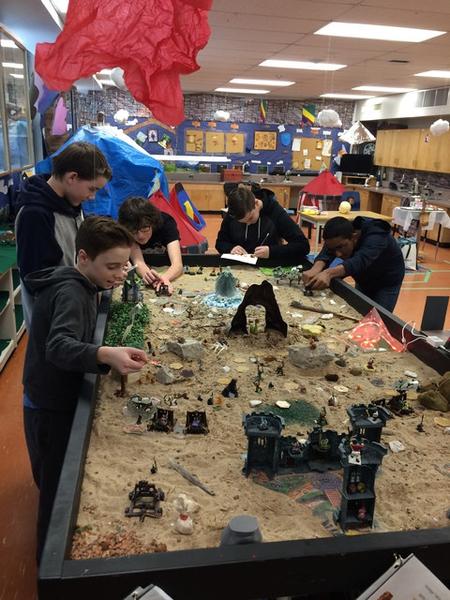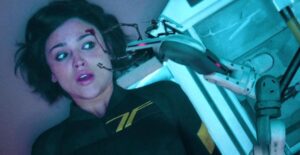Gamification 101

Growing up, school was a boring place but it did not start that way. When I first arrived at school in kindergarten, it was a joy. There was play, fun, exploration, and discovery. I spent little time sitting still and more time moving about exploring my environment, learning along the way. As I grew older, school began to change into a rigid, boring, environment where I felt my voice was less valued and my creativity was being eroded away with each wave of worksheet after worksheet. Moving about the room was Traditional School – yawn! removed entirely and I was met with the familiar refrain of desks in never-ending rows and an emphasis on silence. So, I decided to dedicate my entire career to squashing the notion that education had to be the way it always had been.
When I first started teaching grade 8 sciences, the light bulb went off for me as I walked into my new classroom to find students either totally disconnected from the subject or just doing because they had to with no vested interest. There were some students who were engaged but it just did not feel right. Enter gamification! “What if school were treated like a game?” Armed with the only book I could find, “The Multiplayer Classroom – Designing Coursework as a Game” by Lee Sheldon I set off to radically change my classroom and education for my students.
So what is gamification?!
It is the idea of using game design elements in a non-traditional setting. Going deeper than that, you can extend the system to mimic anything you would like to do. The power of this approach, while unconventional, resonates with all students because we as humans have an innate drive to want to play and have fun. There is a common belief that play is the antithesis of learning but that could not be any more untrue. When we are engaged and enjoying ourselves, the learning sticks.
I chose to prep students for real scenarios but totally revamping everything that I did from content delivery to assessment, to work creation. The results were spectacular! I saw engagement, unlike anything I had ever seen. Grades (although I am not pro emphasis on grades) were rising and teamwork skills were increasing. On a personal note, I was also having so much more fun in my classroom, and my joy and enthusiasm began to permeate through to my students.
Here are the different elements that are built into my gamified classroom. You can incorporate any of these to any degree. A gamified classroom is quite dynamic!
Gamification Starting Points!
Story & Narrative: Like a good book or movie that captures your attention, having a long-running story with a target to reach, coupled with a running narrative of people you meet, help and interact with keeps the engagement moving forward as the story deepens.
Cross Curricular Design: Although I teach science, I have incorporated multiple elements from different subjects. Movement, arts, mathematics and language arts are all present to some degree in this program. The running narrative contains a rich vocabulary challenging students of all reading levels and comprehensions.
 Story is a powerful gamification tool and in my humble opinion – a must! Mystery: Using unexpected twists and turns, little explanation and leaving a lot up for interpretations it primes students to be creative, patient and quick thinking. #wsite-video-container-311402930613000239{ background: url(//www.weebly.com/uploads/b/13773605-317599178372877514/video_demo_503.jpg); } #video-iframe-311402930613000239{ background: url(//cdn2.editmysite.com/images/util/videojs/play-icon.png?1575591387); } #wsite-video-container-311402930613000239, #video-iframe-311402930613000239{ background-repeat: no-repeat; background-position:center; } @media only screen and (-webkit-min-device-pixel-ratio: 2), only screen and ( min-device-pixel-ratio: 2), only screen and ( min-resolution: 192dpi), only screen and ( min-resolution: 2dppx) { #video-iframe-311402930613000239{ background: url(//cdn2.editmysite.com/images/util/videojs/@2x/play-icon.png?1575591387); background-repeat: no-repeat; background-position:center; background-size: 70px 70px; } } Video Content from Mr. Hebert & Created by Bored Teachers/We Teach Let’s Talk! Jobs: I offer a variety of jobs in my class where they earn currency in the game. To get them they need to apply then submit a resume then take a job interview (if too many applicants) and follow a work schedule. Custodians, shopkeepers, designers, engineers, etc… They miss work or do a bad job they need re-training or are let go.
Story is a powerful gamification tool and in my humble opinion – a must! Mystery: Using unexpected twists and turns, little explanation and leaving a lot up for interpretations it primes students to be creative, patient and quick thinking. #wsite-video-container-311402930613000239{ background: url(//www.weebly.com/uploads/b/13773605-317599178372877514/video_demo_503.jpg); } #video-iframe-311402930613000239{ background: url(//cdn2.editmysite.com/images/util/videojs/play-icon.png?1575591387); } #wsite-video-container-311402930613000239, #video-iframe-311402930613000239{ background-repeat: no-repeat; background-position:center; } @media only screen and (-webkit-min-device-pixel-ratio: 2), only screen and ( min-device-pixel-ratio: 2), only screen and ( min-resolution: 192dpi), only screen and ( min-resolution: 2dppx) { #video-iframe-311402930613000239{ background: url(//cdn2.editmysite.com/images/util/videojs/@2x/play-icon.png?1575591387); background-repeat: no-repeat; background-position:center; background-size: 70px 70px; } } Video Content from Mr. Hebert & Created by Bored Teachers/We Teach Let’s Talk! Jobs: I offer a variety of jobs in my class where they earn currency in the game. To get them they need to apply then submit a resume then take a job interview (if too many applicants) and follow a work schedule. Custodians, shopkeepers, designers, engineers, etc… They miss work or do a bad job they need re-training or are let go.
Money Management: I give them currency as a reward for all kinds of things. They then learn to save and plan with their money for larger items and strategy becomes a focal point. It also teaches them the value of money – something many people think doesn’t exist in our youth.  Various jobs in the land of Scientia Terra! Problem Solving: Using an augmented reality platform they can scan and a la RPG things come to life. They meet people in trouble and help them – if they wish – knowing there could be consequences for not helping or benefits for helping. Also, their work is vague and left for interpretation. They interpret and often produce clever and new forms of tired old work. They actively are solving, and even finding, problems. This is crucial in science because many of the problems we are trying to solve globally require unique interpretations and creative approaches.
Various jobs in the land of Scientia Terra! Problem Solving: Using an augmented reality platform they can scan and a la RPG things come to life. They meet people in trouble and help them – if they wish – knowing there could be consequences for not helping or benefits for helping. Also, their work is vague and left for interpretation. They interpret and often produce clever and new forms of tired old work. They actively are solving, and even finding, problems. This is crucial in science because many of the problems we are trying to solve globally require unique interpretations and creative approaches.
Teamwork/Guilds: You are randomly assigned a team to work together throughout the game. They learn about teamwork and collaboration. The most successful stick it out and work together. They learn that changing to be with friends doesn’t always work – they learn the grass isn’t always greener. They walk out better group members.
Negotiations: Players can barter, buy, sell and trade items with me and their peers. They learn incredible negotiating and planning skills. The things kids have pulled off are incredible. The perks and slick speech is nothing I could teach them traditionally.
Observation: Science is about observation. That didn’t happen enough in my past classes. I add puzzles, treasure hunts and open-ended clues that force true observation and strategy. They are so much more observant of the world around them now.
Leaderboard: A way to track the progress between different players and different classes and teams. Tracking your progress allows you to plan ahead and strategize. I also offer up multiple bonus missions to cement knowledge for people who want to move and do extra. Emphasizes growth versus the traditional vantage point of school which is lost.
 Some BattleBoard planning! Game Cards: A basic form of extrinsic motivation that allows students to circumvent rules in the game, as well as the traditional classroom. Help develop a sense of accomplishment.
Some BattleBoard planning! Game Cards: A basic form of extrinsic motivation that allows students to circumvent rules in the game, as well as the traditional classroom. Help develop a sense of accomplishment.
Theme: The class is redesigned to fit the feel of a medieval world. Using basic props and some creativity I have developed a space that helps students feel like they are in a different room and/or era of time. I would argue that theme is the single most important thing to consider because it is where everything stems in your design. It is like the trunk of the tree and everything branches off from there!
Guild Battles (Review Games): Using fun and games is great! By revamping old board games and tweaking the rules I have been able to create unique ways to review for tests.
Badges: Sometimes you want to reward students for doing things when no one is looking or for doing some great! The badge system is a set of custom stickers the can earn just like an X-Box achievement, you know the name but not how to earn them.
So, the biggest gripes I tend to receive from educators who hear about this teaching methodology are, “How do games make kids better learners?” and “How is this going to help them in the real world, you’re not helping them you’re harming them!” We, in the world of education, want to see changes but are hesitant and scared when they happen. Some feel like anything out of the normal education will ruin kids. But it’s not true. My classroom is more than games and more than fun. It took me hours of planning and trial and error to get it right, and it continues to evolve even to this day.
For teachers interested in learning more about using gamification in the classroom, please feel free to explore my website. It contains a blog, a store, examples, and tutorials about how to do things both big and small; or my YouTube channel where I am slowly but surely creating instructional videos for teachers on this concept; and a teacher’s guide full of examples, templates and blackline masters to help anyone learn how to design their program to best fit their students, any grade, any subject, and any school, budgets big or small.
Teacher to teacher, never be afraid to change your classroom and never be afraid to be the loudest voice for your students. In the real world, we would never stand for a company that refuses to progress but in education, we are OK with it. Why? Just because something has been done one way for a long time, it doesn’t mean it needs to remain that way. Be the agent for change your students need.
Press start to begin!







